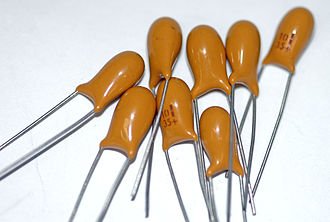Points of Discussion
Definition and Overview
A tantalum capacitor is one kind of electrolytic capacitor, which is a passive electrical device. It uses a capsule of spongy tantalum metal as an anode. An insulating layer of oxide covers the anode. The oxide layer further generates the dielectric. It is surrounded by a solid or non-solid electrolyte, which serves as a cathode.
Tantalum capacitors are characteristics of high capacitance per volume or high volumetric efficiency because of its very reasonable and high permittivity dielectric layer. The increased capacitance value differentiates the tantalum capacitor from other types of electrolytic capacitors. It is also a more expensive capacitor than any different electrolytic kind.
This type of capacitor is polarized inherently. To form a non-polarized or bipolar tantalum capacitor, two polarized capacitors are connected in series. Their anodes are oriented in opposite directions.

Basic Principle
Electrolytic capacitors store electrical energy as a typical capacitor. It holds electrical power by separation charge in an electric field in the dielectric oxide layer between two conductors.
The solid electrolyte is the cathode, forming another electrode of the capacitor. An electrolytic capacitor is different from supercapacitors or electrochemical capacitors, where the electrolyte is generally the ionic conductive connection.
A positive valued voltage is applied at the anode side of the tantalum electrolyte capacitor. The applied voltage causes the generation of a thin oxide layer. This oxide layer functions as the dielectric material of the capacitors.
The characteristics of the oxidised layer can be depicted using the below table.
| Anode Material | Dielectric Material | Relative Permittivity | Structure of Oxide | Breakdown Voltage (V/μm) |
| Tantalum Metal | Tantalum pentoxide [Ta2O5] | 27 | Amorphous | 625 |
| Niobium | Niobium pentoxide [Nb2O5] | 41 | Amorphous | 400 |
The electrolytic works as a cathode for a tantalum electrolytic capacitor. Several types of electrolytes are used. In general, two types of electrolytes are used – soli and non-solid.
Any liquid medium that has an ionic conductivity medium can be treated as a non-solid electrolyte. Concrete types of electrolytes have electron conductivity, and that is why solid electrolytes are more sensitive to voltage sparks. The oxide layer can be damaged if all of a usdden the polarities of the input voltage is reversed.
The working principle of an electrolytic tantalum capacitor is based on a ‘plate capacitor.’
The capacitance can be defined as the below-mentioned formula –
C = ε * (A /d)
C gives the value of the capacitance; A gives the area of the electrode, d represents the distance between the plates, and ε gives us the value of permittivity.
Capacitance can be increased if the electrode area is increased, and the dielectric permittivity is increased.
If we look in detail, a tantalum electrolytic capacitor has a tinny dielectric layer, and its construction is in the range of nm/volt. Also, the voltage strengths of the formed oxide layer are high enough. Now, this thin dielectric is combined with high voltage oxide dielectric and generates high volumetric capacitance. That is why an electrolytic tantalum capacitor has a higher capacitance than an ordinary capacitor. There are also some influences behind the increase in capacitance. That is the rough surface area due to etched and sintered anodes.
The desired voltage rating of an electrolytic capacitor can be easily produced as the oxide layer is dependent on the applied voltage on the anode. Tantalum Electrolytic capacitors have a high “CV product,” explained as the product of capacitance of the capacitor and voltage divided by the volume.
Know more about different types of capacitors!
Construction
A standard tantalum electrolytic capacitor is a blemish capacitor and made up of tantalum powder and sintered into a capsule, which works as the capacitor’s anode. The oxide layer, which works as a dielectric, is made up of tantalum pentoxide. The cathode of the capacitor is a stable manganese dioxide electrolytic.
Anode
As mentioned previously, a tantalum capacitor usages tantalum powder as an anode. The powder is manufactured from pure tantalum metal. Capacitor times volts is the parameter to measure the figure of merit of the powder.
The metallic powder is bounded by tantalum wires (riser wire) to form the capsule or ‘pellet.’ The bounding wire works as the tantalum capacitor’s anode connection.
Larger surface areas give higher capacitance value. That is why powders having high CV/g and smaller average particle sizes are used for high capacitance low voltage parts. A specific voltage can be achieved if we can choose the correct type of powder and an almost perfect temperature for sintering. A suitable sintering temperature can be around – 1200-1800 degrees Celsius.
Dielectric
An electrochemical process named anodization forms the dielectric over the tantalum particles. The primary step to creating this is that the ‘pellet’ is submerged into a very frail solution of an acid and the supplied DC voltage.
Like any other electrolytic capacitor, the thickness of the dielectric layer depends upon the total applied voltage. At the beginning of the process, the power supply is kept in steady current mode until and unless the dielectric thickness is reached. After that, the voltage is held, and the current can decay to get zero value. This process provides an unvarying consistency throughout the device.
The chemical equations are represented below.
2 Ta → 2 Ta 5+ + 10 e−
2 Ta 5+ + 10 OH− → Ta2O5 + 5 H2O
Formation of oxides also took place on the surface of the material during the process. The oxide ultimately grows into the material. There is a specific way the oxide grows. Each unit thickness of oxide growth, the two-third share goes inside, whereas one-third share goes outside. The limit of the maximum voltage rating is also due to the limit in the oxide growth.
There is a safety margin in the oxide layer thickness.
Cathode
The process to form the cathode is the pyrolysis of manganese nitrate into the manganese dioxide. After the pellet submersion, that is baked to produce the dioxide cover at around 250 degrees Celsius. The chemical equations are represented below.
Mn (NO3 )2 → MnO2 + 2 NO2
To build up a thick layer of the coat over both internal and external service areas, the process is repeated repeatedly through fluctuating specific gravities of nitrate solutions.
Types of the Tantalum Capacitors
There are several styles of tantalum capacitors.
Tantalum Chip Capacitors: 80% of tantalum capacitors are of this type. They are categorized for surface mounting.
Tantalum ‘Pearls’ capacitors: They are specially designed for PCB mounting. They are dipped in resin.
Axial leaded tantalum capacitors: Mostly used in military, medical and space applications. It has both tangible and non-solid electrolyte.
Know about Ceramic Capacitors!
Electrical characteristics
Series equivalent circuit
Capacitors are designated as an ideal series equivalent circuit with electrical constituents. But, tantalum capacitors can not be marked as idealistic capacitors.
The circuit below specifies the model.

C is the capacitor’s capacitance; RESR is the equivalent series resistance, which takes into account all the ohmic losses. LESL is the self-inductance of the capacitor. Bleak is the leakage resistance.
Capacitance, standard values, and tolerances
The construction of electrode determines the electrical characteristics of an electrolytic tantalum capacitor. The capacitance also depends on the frequency and temperature parameters. The unit of the capacitance of an electrolytic tantalum capacitor depends on microfarad (mu f).
- Particular applications determine the required tolerance of capacitance.
- This does not need narrow tolerances.
Ready and Category voltage
The allowable operating voltage for a tantalum electrolytic capacitor is known as rated voltage or nominal voltage.
Applying higher voltage than the rated one may lead to the destruction of the tantalum electrolytic capacitor. Applying lower voltage has also influenced the capacitor. A lower voltage can extend the lifetime. Sometimes it increases reliability for it.
Surge Voltage
IEC/EN 60384 standardized surge voltage is the maximum amount of peak voltage which is supplied as input to the capacitors. It is measured for the duration of the capacitor’s applications in no of cycles.
Transient voltage
If a transient voltage or a current spike is applied to tantalum electrolytic capacitors, which ha stable manganese dioxide as the electrolytic material, that will lead the capacitor to fail.
Reverse voltage
A typical tantalum electrolytic capacitor is polarized and, in general, have need of the anode must be positive relative to cathode.
Tantalum capacitors can withstand reverse voltage for a short period. Sometimes the reverse voltage may be used for applications in permanent AC circuits.
Impedance
A standard capacitor is considered as a storage component in electrical energy. Sometimes capacitors are deployed in Alternative Current circuits as resistive elements. An electrolytic capacitor is used as a decoupling capacitor in a course. It blocks the DC component of the signal with the help of the dielectric material.
Leakage Current
The leakage current of tantalum capacitors differentiates these type of capacitors or it can be the identity of these capacitors. The value of leakage current be influenced by on the anode’s applied voltage and temperature.
Symbol of capacitor
Electrolytic capacitors have a particular type of symbol for representing circuits. It is almost similar to the regular capacitor symbol, but a plus sign makes a difference.

Hi, I am Sudipta Roy. I have done B. Tech in Electronics. I am an electronics enthusiast and am currently devoted to the field of Electronics and Communications. I have a keen interest in exploring modern technologies such as AI & Machine Learning. My writings are devoted to providing accurate and updated data to all learners. Helping someone in gaining knowledge gives me immense pleasure.
Let’s connect through LinkedIn –